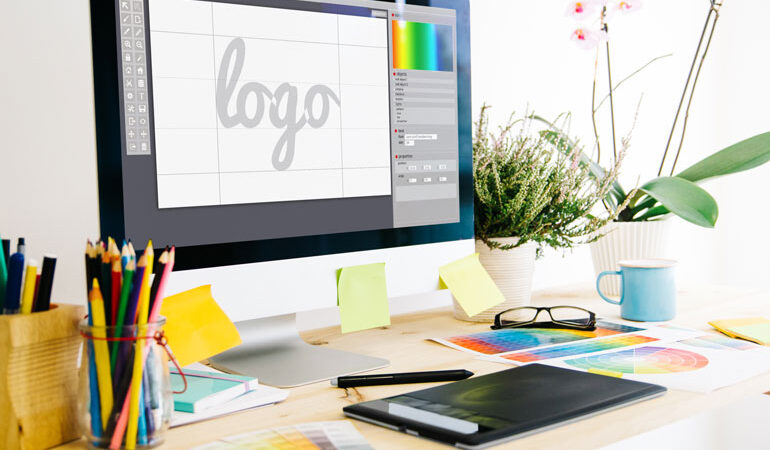
The Essence of Simplicity
The most memorable logos in history share one common trait: simplicity. A good logo design should be straightforward yet powerful, free from unnecessary elements that could cloud its message. Simplicity ensures that the logo is versatile, scalable, and easy to recognize at a glance. In the fast-paced digital age, where attention spans are short, the ability of a logo to convey a brand’s essence succinctly is invaluable.
The Power of Typography
Typography is a critical component of logo design, carrying the weight of brand personality on its shoulders. The choice of typeface should reflect the brand’s character—be it elegant, strong, whimsical, or modern. Custom typography goes a step further, offering exclusivity and distinctiveness in a crowded marketplace. The artistry lies in selecting or creating a typeface that not only looks visually appealing but also resonates with the target audience on an emotional level.
Color Psychology
Colors speak louder than words. The colors chosen for a logo can evoke emotions, convey messages, and influence perceptions. Understanding color psychology is paramount in good logo design. Each color has its own set of associations and effects on the viewer. For instance, blue can evoke trust and professionalism, while yellow can signify energy and optimism. The key is to choose a palette that aligns with the brand’s identity and aspirations, crafting a visual language that speaks directly to the viewer’s psyche.
Symbolism and Metaphor
A logo often serves as a symbolic representation of a brand’s story, values, or mission. The use of symbols and metaphors can imbue a logo with depth and meaning, making it not just a mark, but a narrative. This storytelling aspect of logo design is what transforms a good logo into a great one. It invites the audience to delve deeper, fostering a connection that transcends the visual.
Balance and Proportion
The aesthetics of a logo—its shape, size, and composition—should be carefully considered to achieve balance and harmony. The elements of the logo must be proportioned and arranged in a way that pleases the eye and creates a sense of stability. This includes the logo’s symmetry, the weight of its lines, and the spacing between letters and symbols. A well-balanced logo is aesthetically pleasing and projects a sense of professionalism and reliability.
Versatility and Adaptability
A good logo design must stand the test of time and adapt to various mediums and applications. From digital screens and social media profiles to physical products and print materials, the logo should maintain its integrity and recognizability across different formats. This requires designing with foresight, ensuring the logo is effective in color as well as black and white, scalable to different sizes without losing detail, and legible on both large and small scales.
Authenticity and Uniqueness
In a saturated market, a logo must be unique to stand out. However, uniqueness should not come at the expense of clarity or relevance. A good logo design finds the sweet spot between being distinctively different and authentically aligned with the brand’s core identity. This originality is what sets a brand apart, making its logo a beacon for its values and vision.
Flexibility in Design
A logo must be flexible enough to evolve with the brand over time. While consistency is key to brand recognition, the ability to update or tweak a logo without losing its essence allows a brand to stay current and relevant. This flexibility can be built into the logo design from the start, allowing for minor adjustments that reflect growth or changes in the brand’s direction without necessitating a complete redesign.
Cultural and Global Considerations
In our interconnected world, a good logo design must resonate across different cultures and geographies. This means being mindful of cultural sensitivities and symbols to ensure the logo is universally appealing and does not inadvertently offend or alienate any part of your target audience. A successful logo transcends language and cultural barriers, making the brand accessible and appealing to a global audience.
Responsiveness to Trends
While it is important for a logo to be timeless, responsiveness to current design trends can keep a brand looking modern and fresh. This does not mean chasing every trend but rather being aware of how changes in design philosophy and consumer preferences might influence perceptions of your logo. Incorporating modern design principles without sacrificing the logo’s core identity can help keep the brand relevant in a changing marketplace.
Emotional Engagement
A good logo design should evoke an emotional response from its audience. It should connect on an emotional level, making people feel something when they see it. This connection can be a sense of trust, excitement, happiness, or any other emotion aligned with the brand’s values. The ability to engage people emotionally is what transforms a logo from a mere graphic into a symbol people care about and have loyalty to.
Integration with Brand Strategy
A good logo design is intricately linked to the overall brand strategy, reflecting the brand’s mission, vision, and values. It should serve as a visual summary of what the brand stands for, encapsulating its unique selling propositions and target audience within its design. This integration ensures that the logo reinforces the brand’s message and contributes to building a coherent brand identity across all touchpoints. A logo that is well-aligned with the brand strategy not only enhances brand recognition but also deepens brand loyalty by consistently communicating the brand’s core values and promises.
The anatomy of a good logo design is complex, involving a delicate balance of aesthetics, psychology, and strategy. At Rabbit, we are dedicated to navigating this complexity, bringing our client’s visions to life through logos that speak, resonate, and endure. With our bespoke logo plans, we offer a tailored approach to logo design, ensuring that each element of your logo’s anatomy is crafted with precision and purpose. Unveiling the anatomy of a good logo design is not just about creating a symbol; it is about weaving the very soul of a brand into a visual form that captivates and endures.


